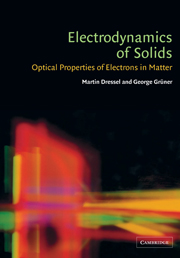Book contents
- Frontmatter
- Contents
- Preface
- 1 Introduction
- PART ONE CONCEPTS AND PROPERTIES
- 2 The interaction of radiation with matter
- 3 General properties of the optical constants
- 4 The medium: correlation and response functions
- 5 Metals
- 6 Semiconductors
- 7 Broken symmetry states of metals
- PART TWO METHODS
- PART THREE EXPERIMENTS
- PART FOUR APPENDICES
- Index
2 - The interaction of radiation with matter
Published online by Cambridge University Press: 20 May 2010
- Frontmatter
- Contents
- Preface
- 1 Introduction
- PART ONE CONCEPTS AND PROPERTIES
- 2 The interaction of radiation with matter
- 3 General properties of the optical constants
- 4 The medium: correlation and response functions
- 5 Metals
- 6 Semiconductors
- 7 Broken symmetry states of metals
- PART TWO METHODS
- PART THREE EXPERIMENTS
- PART FOUR APPENDICES
- Index
Summary
Optics, as defined in this book, is concerned with the interaction of electromagnetic radiation with matter. The theoretical description of the phenomena and the analysis of the experimental results are based on Maxwell's equations and on their solution for time-varying electric and magnetic fields. The optical properties of solids have been the subject of extensive treatises [Sok67, Ste63, Woo72]; most of these focus on the parameters which are accessible with conventional optical methods using light in the infrared, visible, and ultraviolet spectral range. The approach taken here is more general and includes the discussion of those aspects of the interaction of electromagnetic waves with matter which are particularly relevant to experiments conducted at lower frequencies, typically in the millimeter wave and microwave spectral range, but also for radio frequencies.
After introducing Maxwell's equations, we present the time dependent solution of the equations leading to wave propagation. In order to describe modifications of the fields in the presence of matter, the material parameters which characterize the medium have to be introduced: the conductivity and the dielectric constant. In the following step, we define the optical constants which characterize the propagation and dissipation of electromagnetic waves in the medium: the refractive index and the impedance. Next, phenomena which occur at the interface of free space and matter (or in general between two media with different optical constants) are described. This discussion eventually leads to the introduction of the optical parameters which are accessible to experiment: the optical reflectivity and transmission.
Information
- Type
- Chapter
- Information
- Electrodynamics of SolidsOptical Properties of Electrons in Matter, pp. 9 - 46Publisher: Cambridge University PressPrint publication year: 2002
